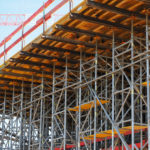Key Responsibilities of a Scaffolder

Erecting and Dismantling Scaffold Structures
Scaffolders are responsible for assembling scaffolding systems according to the specifications outlined in construction plans. This includes selecting the appropriate type of scaffolding for the project and assembling its components in a way that guarantees stability and safety for workers.
They must also efficiently dismantle scaffolding structures that are no longer needed, ensuring that all components are carefully removed and properly stored to prevent damage and facilitate future use.

Inspecting Scaffolding Components
Before and during use, scaffolders must thoroughly inspect all scaffolding components for any signs of damage or wear that could jeopardize the structure’s stability. This includes checking for rust, cracks, or bent parts that could weaken the scaffolding. Regular inspections allow scaffolders to identify and address potential issues promptly, reducing the risk of accidents or structural failures on site.

Adhering to Safety Regulations and Standards
Safety is paramount in the construction industry, and scaffolders play a vital role in ensuring that scaffolding systems comply with all necessary safety regulations. This includes following guidelines established by organizations such as the Health and Safety Executive (HSE) and adhering to industry best practices for scaffolding erection and use. Scaffolders must stay informed about updates or changes in safety standards and implement them accordingly to promote a safe working environment.
Collaborating with Construction Teams
To coordinate their efforts effectively, scaffolders must work closely with other tradespeople and construction teams. Clear communication with project managers, contractors, and other workers is essential to understanding project timelines, site logistics, and scaffolding requirements.
By collaborating with others on the construction site, scaffolders can help ensure that scaffolding is erected and utilized to support the overall progress of the project.
Skills to Look for When Hiring a Scaffolder
When hiring a scaffolder, certain skills are essential to identify a quality candidate. Look for:
Knowledge and Experience: Scaffolders must have a solid understanding of the rules and regulations necessary for safe and efficient scaffolding operations, which can be acquired through training and hands-on experience.
Attention to Detail: Inspections of scaffolding components are crucial for identifying potential safety hazards, so thorough attention to detail is vital.
Practical Skills: Proficiency in hands-on tasks is important for scaffolders to effectively use scaffolding systems.
Physical Fitness: The nature of the work demands good physical condition, as it involves lifting heavy materials, climbing ladders, and working at heights safely and effectively.
Equipment Operation: Scaffolders should be able to operate scaffolding equipment, including hoists, lifts, and power tools, to ensure a smooth workflow and minimize the risk of accidents on site.
Understanding of Public Safety: Scaffolders must follow public safety protocols and regulations to mitigate risks for both workers and the public.
Teamwork Skills: Effective collaboration with other construction team members is essential for project completion, requiring strong communication skills and adaptability to achieve common objectives.
Patience: Remaining composed in challenging situations is key for scaffolders, allowing them to plan and execute tasks with accuracy and safety.
Rely on the Scaffolding Experts at Silvercrest Scaffolding
Silvercrest Scaffolding has been providing scaffolding since 2008 with a specialism in small and rapid works. As an experienced company we can support you with insurance works, we are licensed to undertake asbestos removal works and have extensive experience in obtaining permissions for scaffolding such as pavement license applications.
If you are seeking expertise in scaffolding, trust the professionals at Silvercrest Scaffolding for comprehensive support and guidance.









